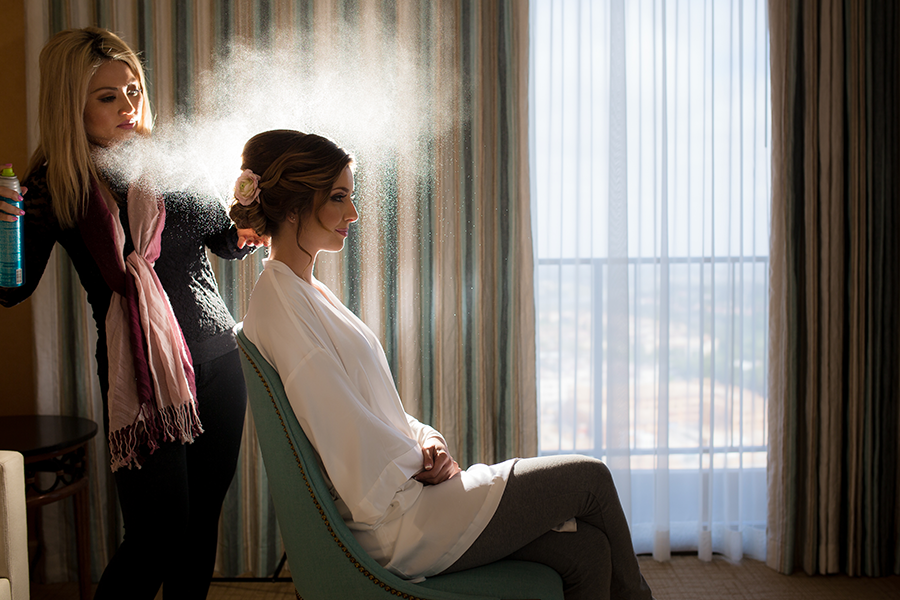
One of the most challenging aspects of being a wedding photographer is that, oftentimes, you have absolutely no control over the situations you face while photographing. One such challenging aspect is the lighting conditions that you may encounter during a shoot. Knowing how to use off camera flash and when to use it could help you overcome these challenging wedding photography lighting scenarios. On a wedding day, you might start photographing your couple and their close ones right from the time they begin getting ready. Now, your couple could have chosen a hotel suite, a bungalow, or a room provided at the wedding venue to get ready. Depending on the location, you might be able to shoot most of these images with natural light. However, using off camera flash during the getting ready scene is a great way to add some drama to an otherwise potentially dull scene. Wondering how you could achieve that? Check out the scenarios and solutions described ahead!
HOW TO USE OFF CAMERA FLASH

In the Off Camera Flash Techniques for Wedding Photographers Guide, created by ShootDotEdit, a wedding photo editing company for wedding photographers, and SLR Lounge, we’ve discussed a few scenarios that you might encounter while photographing the getting ready part of the day. Below, we will show you how Pye Jirsa from SLR Lounge and Lin & Jirsa Photography personally sets up the lighting for the getting ready scene to create unique and dramatic images.
 Images Courtesy of Lin & Jirsa Photography
Images Courtesy of Lin & Jirsa Photography
Scenario:
1. Part of Wedding Day: Getting Ready2. Location: Hotel Room
3. Lighting Condition: Natural Light From The Windows
4. Subject(s): Bride and Hair Stylist
In this scenario, the goal is to create a dramatic image of the bride as her stylist applies hairspray to set the bride’s hair. To achieve this, a mixture of ambient light is used from two windows in the hotel, along with one Phottix Mitros flash with a CTO gel on it. Note that if you don’t have the specific flashes that are referenced here, you can always supplement with your Canon or Nikon off camera Speedlight.
As you can see in the image below, the bride is seated in a chair with her profile toward the camera, and her stylist behind her. The flash is set to auto-zoom so Pye can control it from the receiver on the camera, and the light is placed to the left of the bride, directly in front of a window.

Images Courtesy of Lin & Jirsa Photography
Take a look at the image above again to see the off camera flash setup. The placement of the flash is crucial in this scenario to learn how it lights the bride. When setting up the flash, Pye positions it in a way so that it is high enough to shine down on her, rather than lower and angling it up toward her face.

This creates a flattering light and does not highlight certain areas, such as her chin. Additionally, Pye makes sure the flash is hidden from view as he frames the shot - this is when having an assistant or second shooter can be especially helpful!
Once the flash is properly positioned, as shown above, the next step is to get the proper exposure for the background. This is important because if the background is too bright, the hairspray will not be visible. In the image below, you can see how the hairspray disappears into the bright background, and because of this, Pye needs to make some adjustments to the image.

Images Courtesy of Lin & Jirsa Photography
To adjust this, Pye takes the following steps:
Step 1: Since he cannot adjust his shutter speed and is already at the lowest ISO, he stops down his aperture from f/1.4 to f/2.8 to create a darker background.
Step 2: He moves the flash closer to the bride and reduces the flash power from 1/4th to 1/8th. Because he adjusted his aperture to let less light in, he doesn’t need to adjust the flash much in this scenario.
Step 3: He partially closes the curtain to the left of the bride to darken the area the hairspray will reach. As you can see in 1D, he leaves the curtain partially open to keep a rim light on her face.
Step 4: He opens the window curtain in front of the bride to act as a fill light for the front of her face. This keeps her from becoming a silhouette in the image.
With these four adjustments, the hairspray shot is created, as seen below.

Images Courtesy of Lin & Jirsa Photography
By combining artificial and ambient light, you can create a dramatic image during a getting ready scene. This is just one of many images you can take during the getting ready portion of the wedding day. Even better, this basic wedding photography lighting setup can also be utilized in other scenarios you may encounter during the wedding. Knowing how to use off camera flash to create those dramatic wedding photos can give you an edge over other photographers and impress your clients. And happy clients mean a happier you - and a growing business!
If you want to discover additional resources for your business with SLR Lounge Premium, you can learn more about it here. For amazing wedding photography-specific tips and tricks, you can check out our other blogs.
Further Read: Flash Photography Tips: A Brief Intro To Artificial Lighting
At ShootDotEdit, we love sharing tips and ideas that can help you hone your skills as a wedding photographer. What we also love is providing professional photo editing services to you so that your post-production workload is reduced and you can focus on building your brand. To learn more about how we do that, you can take a look at our pricing plans.


Leave a comment